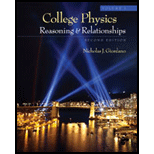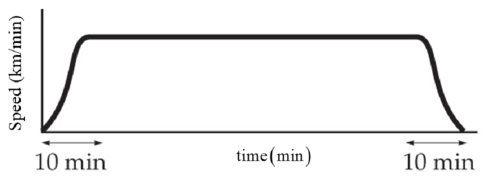
Concept explainers
(a)
The sketch of speed – time graph.
(a)
Answer to Problem 54P
The sketch of speed – time graph of air plane is drawn.
Explanation of Solution
The below figure shows the speed time graph of the airplane.

Airplane was initially at rest on the ground, accelerates quickly and gains its top speed in first 10 minutes and then it travels with constant speed and then while it lands off it decelerates quickly to the ground similar to the acceleration while taking off.
Conclusion:
The sketch of speed – time graph of air plane is drawn.
(b)
The average speed of the trip.
(b)
Answer to Problem 54P
The average speed of the trip is 240 m/s
Explanation of Solution
Write the expression to calculate the average speed.
vavg=ΔxΔt (I)
Here, vavg is the average speed, Δx is the distance covered, and Δt is the time.
Conclusion:
Substitute 3400 km for Δx and 4.0 h for Δt .
vavg=3400 km4.0 h=3400 km4.0 h(1000 m1 km)(1 h3600 s)=240 m/s
Therefore, the average speed of the trip is 240 m/s
(c)
The top speed in the trip
(c)
Answer to Problem 54P
The top speed in the trip is 250 m/s
Explanation of Solution
For the first 10 min and last 10 min that is for a total of 20 min the average speed of the airplane was half the top speed. For the remaining time 3 hr 40 min the airplane travelled with top speed.
vavg=vtop2
Here, vavg is the average speed of the air plane during 20 min and vtop is the top speed of the airplane.
Write the expression to calculate the total distance travelled by the airplane.
D=vtop(3.0 h 40 min)+vavg(20 min)
Here D is the total distance travelled.
Use vtop2 for vavg in above equation and rewrite it.
D=vtop(3.0 h 40 min)+vtop2(20 min) (I)
Conclusion:
Substitute 3400 km for D in (I) and simplify.
3400 km=vtop(3.0 h 40 min)+vtop2(20 min)3400 km(1000 m1 km)=vtop(3.0 h 40 min)(3600 s1 h )(60 s1 min)+vtop2(20 min)(60 s1 min)3.4 × 106 m=vtop speed×(13,200 s) + vtop speed2 × (1200 s) vtop speed=3.4 × 106 m13,800 s=250 m/s
Therefore, the a top speed of the trip is 250 m/s
(d)
The average acceleration during first 10 min.
(d)
Answer to Problem 54P
The average acceleration during first 10 min is 0.42 m/s2
Explanation of Solution
Write the expression for average acceleration during first 10 min.
aavg=vtopΔt
Here, aavg is the average acceleration of the air plane during first 10 min.
Conclusion:
Substitute 250 m/s for vtop and 10 min in (I) and simplify.
aavg=250 m/s10 min=250 m/s10 min(1 min60 s)=0.42 m/s2
Therefore, the average acceleration during first 10 min is 0.42 m/s2
(e)
The average acceleration during the central hours of the trip.
(e)
Answer to Problem 54P
The average acceleration during the central hours of the trip is 0
Explanation of Solution
During the central hours of the trip, the airplane travelled with top speed. Top speed is constant and hence during the central hours of the trip the acceleration was zero.
Conclusion:
Therefore, the average acceleration during the central hours of the trip is 0
Want to see more full solutions like this?
Chapter 2 Solutions
College Physics, Volume 1
- If the car in the previous problem increases its power output by 10% (by pressing the gas pedal farther down), at what rate will the car accelerate? Hint: Consider the net force. In the previous problem the power was 31.8kWarrow_forwardWhat power is required (at the wheels) for a 1400 kg automobile to climb a 4% grade at a constant speed 30 m/s while it is opposed by drag and rolling resistance forces totaling 500 N?arrow_forwardNo chatgpt pls will upvotearrow_forward
- As a box is lifted against gravity and placed on a shelf, how does the work done by the lifter compare with the work done by gravity? What is the net work done on the box? What does this imply about its change in kinetic energy? Use definitions and mathematics from this chapter to answer these questions.arrow_forwardAs I carry a box up a flight of stairs, am I doing positive work or negative work on the box? Provide a mathematical explanation.arrow_forwardAs a ball falls under the influence of gravity, does gravity do positive work or negative work? Provide a mathematical explanation.arrow_forward
- Under what circumstances is it bad to describe kinetic energy as k = 1/2mv^2arrow_forwardNo chatgpt pls will upvotearrow_forwardAir temperature of 37 °C increases swimming pool temperature of 2.55 °C. What is the fraction of the water in the pool must evaporate during this time to carry enough energy to keep the temperature of the pool constant? 4186 J/(kg°C) = specific heat of water 2,430,000 (2.43 x 106) J/kg = latent heat of vaporization for the water in the pool.arrow_forward
- The iceberg requires 7.4 x 1020 Joules of energy to melt it completely. It absorbs energy from the Sun at a constant average rate of 88 Watts/m2. The total surface area of iceberg exposed to the sunlight is 12 billion (1.2 x 1010) square meters. How long will it take for sunlight to melt the entire iceberg in yearsarrow_forward1.0 kg block of ice to melt in the kitchen. The temperature in the kitchen is 31 °C. The ice starts out at 0 °C and takes an hour to melt and reach the same temperature as the surrounding room (31 °C). How much heat does the 1.0 kg of ice/water absorb from the room as it melts and heats up to 31 °C in Joules absorbed? Latent heat of fusion for water/ice is 334,000 J/kg Specific heat of water is 4186 J/kg°Carrow_forward5.84 If the coefficient of static friction between a table and a uni- form, massive rope is μ, what fraction of the rope can hang over the edge of the table without the rope sliding? 5.97 Block A, with weight Figure P5.97 3w, slides down an inclined plane S of slope angle 36.9° at a constant speed while plank B, with weight w, rests on top of A. The plank is attached by a cord to the wall (Fig. P5.97). (a) Draw a diagram of all the forces acting on block A. (b) If the coefficient of kinetic friction is the same between A and B and between S and A, determine its value. 36.9° 1arrow_forward
 University Physics Volume 1PhysicsISBN:9781938168277Author:William Moebs, Samuel J. Ling, Jeff SannyPublisher:OpenStax - Rice University
University Physics Volume 1PhysicsISBN:9781938168277Author:William Moebs, Samuel J. Ling, Jeff SannyPublisher:OpenStax - Rice University Principles of Physics: A Calculus-Based TextPhysicsISBN:9781133104261Author:Raymond A. Serway, John W. JewettPublisher:Cengage Learning
Principles of Physics: A Calculus-Based TextPhysicsISBN:9781133104261Author:Raymond A. Serway, John W. JewettPublisher:Cengage Learning Glencoe Physics: Principles and Problems, Student...PhysicsISBN:9780078807213Author:Paul W. ZitzewitzPublisher:Glencoe/McGraw-Hill
Glencoe Physics: Principles and Problems, Student...PhysicsISBN:9780078807213Author:Paul W. ZitzewitzPublisher:Glencoe/McGraw-Hill Physics for Scientists and Engineers: Foundations...PhysicsISBN:9781133939146Author:Katz, Debora M.Publisher:Cengage Learning
Physics for Scientists and Engineers: Foundations...PhysicsISBN:9781133939146Author:Katz, Debora M.Publisher:Cengage Learning Physics for Scientists and Engineers with Modern ...PhysicsISBN:9781337553292Author:Raymond A. Serway, John W. JewettPublisher:Cengage Learning
Physics for Scientists and Engineers with Modern ...PhysicsISBN:9781337553292Author:Raymond A. Serway, John W. JewettPublisher:Cengage Learning College PhysicsPhysicsISBN:9781285737027Author:Raymond A. Serway, Chris VuillePublisher:Cengage Learning
College PhysicsPhysicsISBN:9781285737027Author:Raymond A. Serway, Chris VuillePublisher:Cengage Learning





